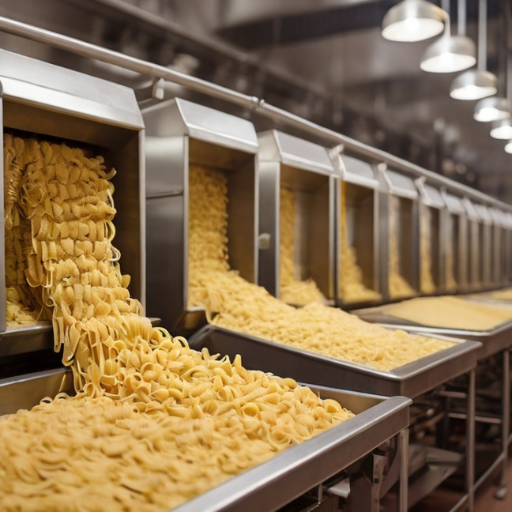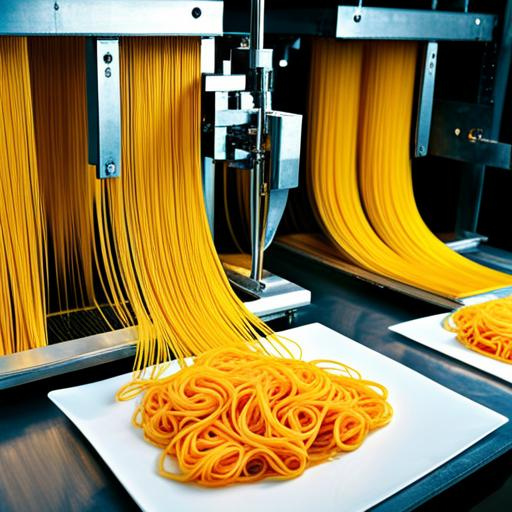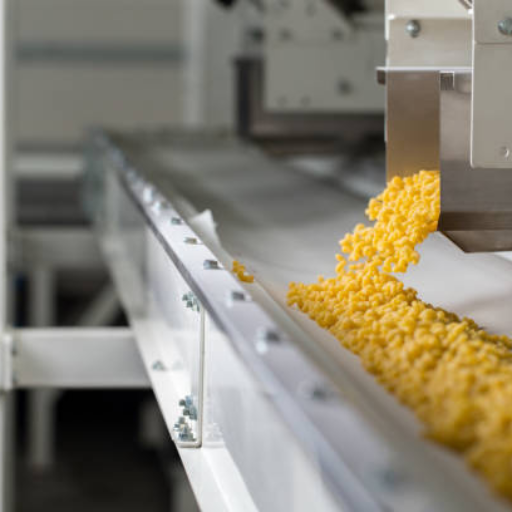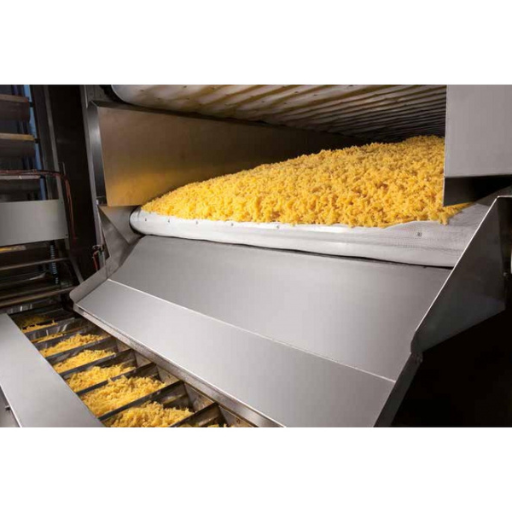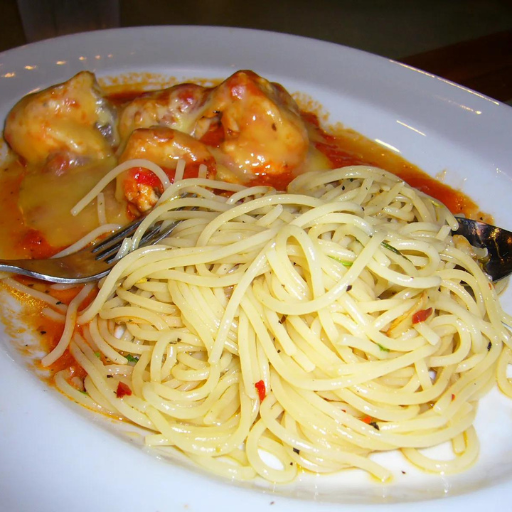Pasta, a staple in many households around the world, has a fascinating journey from raw ingredients to the final product we enjoy on our plates. This blog aims to take you behind the scenes of the largest pasta factory, unraveling the intricacies of modern pasta production. We’ll explore each step of the manufacturing process, from selecting high-quality durum wheat to the final packaging and distribution. Whether you’re a pasta enthusiast or simply curious about how your favorite comfort food is made, this comprehensive guide will provide a detailed glimpse into the world of pasta production. Join us as we delve into the machinery, techniques, and quality control measures that ensure every piece of pasta meets the highest standards.
What are the Raw Materials Used in Pasta Production?
The significance of Durum Wheat Semolina in the Production of Pasta
Durum wheat semolina possesses unique properties that make it an indispensable ingredient in high quality pasta making. It is glutenous and this causes the pasta to be hard yet maintain its shape during boiling. Moreover, durum wheat’s high protein content results into desired chewiness and superior cooking qualities of pasta. The golden color of durum wheat semolina also gives a visually appealing look to the final product which makes it sweet and attractive on the plate. Hence, these are attributes that make use of durum wheat semolina vital for production of premium pasta types.
How is Water used to Mix Semolina into Pasta Dough?
The process by which semolina is intermingled with water to form pasta dough is direct and precise thus ensuring uniformity in quality at the end. First, high grade durum wheat semolina is measured out and placed in large scale mixers. After slowly adding cold water onto semolina mixing bowl (usually one part water for three parts flour though this may vary according to required texture or type), after ascertaining right consistency dough molecules are glued together forming a cohesive mixture using the mixer machine. This stage helps develop gluten which add elasticity and strength to dough hence allowing cohesion within different forms shapes until when smoothness becomes possible thereby resulting into pliable dough from where next steps like cutting or drying may adopted.
Gluten Relevance in Pasta Production Process
Due to its structure, gluten plays a very important role while making pastas by forming a skeletal support for dough production. Gluten proteins create an elastic bond when mixed with water and kneaded into enzyme-rich flour called semolina resulting into network easily identified when one tries stretching out such piece using hands. This gives stability during both extrusion or shaping procedure as well as boiling; otherwise without it would become mushy upon cooking because there would be nothing much holding together causing eventual collapse once subjected to boiling water. Gluten also makes pasta have an elasticity that gives it the required chewiness which differentiates high quality pastas from others. Additionally, this gluten development will prevent the pasta from becoming soft while boiled making it keep its firm “al dente” texture even during cooking. In essence, therefore, gluten is an essential component in determining the texture, consistency and cooking properties of final pasta products.
How is the Pasta-Making Process Carried Out?
Process of Kneading Dough
- Measuring & Mixing Ingredients: The process begins by measuring the best quality durum wheat semolina and then putting it into an industrial mixer. Gradually, cold water is mixed with the semolina; usually in a ratio of 1 part of water to 3 parts of semolina. They are mixed up until they form one even mixture.
- First Stage Mixing: This is done at slow speed first to allow for equal distribution of the water on the semolina. It plays a major role in uniformly hydrating the semolina.
- Kneading: Then, thorough kneading is done for about ten minutes in industrial settings. The gluten develops well when kneaded at moderate speed. This step however involves stretching, folding and pressing dough repeatedly until it has a smooth continuous elastic texture.
- Resting Period: After kneading, the dough should rest for some time which is normally around half an hour. Such period allows relaxation of gluten network hence making subsequent shaping easier.
- Quality Check: Lastly, one checks whether the dough feels right or not. It should be smooth and slightly sticky but not wet. When necessary add small amounts of either water or semolina to improve its consistency before moving to next steps that involve shaping as well as drying.
These stages make sure that pasta dough has been appropriately prepared with correct structure and elasticity needed for production of high-quality pasta.
Mixer and Extruder Operation
Operating the mixer and extruder in manufacturing pasta requires a detailed and accurate approach to achieve highest quality output. Here are the main steps:
Mixer Operation:
- Make sure all parts are clean and free from contamination.
- Set mixer on desired speed according to type of pasta being made; start slowly while combining ingredients then gradually increase to medium speed required for effective kneading.
- Observe mixing to ensure even hydration as well as consistent thicknesses; adjust water or amount of semolina if need be.
Extruder Preparation:
- Choose and fix appropriate die according to the shape of pasta selected.
- Heat the extruder to recommended temperature settings in order to ensure that it is ready for optimal dough flow and shape precision.
- Load kneaded and rested dough into machine’s hopper, avoiding overloading which may cause blocking or inconsistent extrusion.
Extrusion Process:
- Start the flow steadily and controllably to produce similar shapes for all pasta. Check regularly for consistency of dough and modify extruder settings whenever necessary.
- At the exit from the machine, use a sharp cutter to cut continuous lengths of the extruded dough.
- Check uniformity in shape and texture of extruded pasta adjusting mixer or extruder if needed.
Post-Extrusion Procedures:
- Spread out fresh pieces of pasta on drying racks so that they do not stick together.
- Dry as per specified protocols until it attains desired moisture content & texture required for product quality and shelf life respectively.
- By following these steps along with monitoring both equipment and output constantly high-quality, uniform pasta production can be achieved.
Why is Extrusion Important in Forming Pasta Shapes?
Extrusion is important when it comes to shaping pasta because it enables mass production of uniform, high quality shapes that cannot be easily achieved by other means. It entails the dough being pushed through a die so as to create the desired pasta shape. The exactness of extrusion guarantees sameness in thickness and texture which are vital for even cooking and aesthetic attraction. Additionally, extrusion facilitates the large scale making of pasta with little wastage and with great efficiency therefore making it indispensable in both artisanal as well as industrial pasta manufacture.
What is the Drying Process in Pasta Production?
Dry Pasta: Drying Stages for Long and Short Pasta
The drying process of pasta in production is an important step that affects the quality, shelf-life, and cooking properties of the final product. These are the stages involved in drying long and short pasta:
- Pre-Drying: In this phase, there is a brief exposure to high temperatures used to create a protective layer on the pasta. This helps to prevent sticking together and surface cracking. Usually pre-drying should take slightly more amount of time for long pasta than the short one.
- Main Drying: Controlled humidity and temperature are applied during this stage with the aim of reducing gradually its moisture content. The drying process of long pasta takes longer so as to achieve a uniform moisture gradient from center part towards exterior region. Short pastas may dry faster due to their shapes and sizes but still need vigilance against uneven drying.
- Cooling: After main drying period, the pasta slowly cools towards ambient temperature. It is at this stage that stability comes in place preventing re-absorption of moisture, leading to growth of molds and it becoming spoilt fully. Both long as well as short pastas must cool down carefully in order not to lose their texture or quality.
Manufacturers ensure even drying by following through these stages which help them end up with a quality product that cooks well while also increasing its shelf life.
Drying Time And Moisture Content Factors
Various factors influence drying time and moisture content during pasta production are:
- Pasta Shape And Size: The speed at which moisture can evaporate depends on shape or thicknesses of dough noodles; hence thin elongated types like vermicelli dries differently from thick complicated ones such as penne or fusilli.
- Temperature And Humidity Of The Surroundings: High ambient temperatures combined with low humidity hastens evaporation thus speeding up the process while lower room temperatures accompanied by high humidity rate slows it down.
- Drying Temperature And Humidity Control: Temperature and humidity are two factors that must be highly controlled in the drying environment. A higher temperature for drying purposes may result in uneven dryness or destruction caused by heat. Controlled humidity should prevent surface cracking, internal stresses during uniform moisture reduction.
- Airflow: For effective evaporation of moisture, pasta needs to be dried with sufficient airflow. Lack of adequate airflow leads to localized drying which ends up creating an uneven distribution of moisture and potentially weak pasta.
- Initial Moisture Content: The initial water content of the pasta dough will affect the overall drying time. Doughs that have higher relative moisture would naturally require longer times of drying than those with lower starting water concentrations.
Understanding and managing such aspects allows manufacturers to optimize their drying periods hence maintaining consistent quality of their products.
How Does Hot Air Ensure the Quality of the Final Product?
The hot air drying process is vital in pasta making because it determines the quality of the end product. The manufactures maintain optimal drying conditions through consistent use of hot air that ensures uniform moisture content for pasta. Through this, it is possible to avoid surface cracks and internal stresses that may arise due to irregular drying. In addition, controlled application of hot air maintains the texture and firmness of pasta which guarantees that when cooked, it will have the desired al dente characteristic. Moreover, hot air drying regulates temperature and airflow effectively so as to minimize chances of microbial growth hence improving shelf life and safety of final products.
What Types of Pasta are Typically Produced?
Manufacture of Spaghetti and other Long Pasta
Spaghetti and other long pasta types are produced through a painstaking process to ensure uniformity and quality. Initially, durum wheat semolina and water are mixed together to make a paste. The paste is then kneaded in order to form the required gluten structure that will give the pasta its firm yet elastic texture. The paste is forced through metal dies that sculpt it into long strands similar to spaghetti, linguini or fettuccine.
The strands are then cut into the desired lengths, dried in specified conditions of temperature and humidity for different times depending on their thickness, length and nature in order to remove moisture evenly thereby preventing cracking or spoilage. After drying out, packaging is done using materials which protect it until it finally gets to the consumers. The production process involves application of highly advanced technology as well as careful supervision so as to guarantee that the long pasta maintains same hardness during storage as well as cooking.
How Are Macaroni And Other Short Pasta Made?
Macaroni along with other short pasta begins by combining durum wheat semolina with water creating a stiff dough mixture. A lot of effort goes into kneading this dough so that a glutinous network can form which makes sure that each bite of pasta gives you something hard to chew on. Eventually this dough is pressed through specially designed extruders fitted with bronze dies for them to have shapes such macaroni among others penne or rigatoni whereby these shapes are then cut at pre-determined length using high speed cutter machine.
The resultant shapes of the short pastas undergo drying similarly like it does for long ones where temperature control alongside humidity levels help lower water content so that they remain stable throughout hence avoiding possibilities of putrefaction. This period tends not exceed that for drying longer pastas since there shall be less sizes plus thicknesses involved hereinin contrast therewith However once it has been dry all carefully it is checked for any defect before being packed in hardy packing materials that protect its quality up to the point of consumption. As such, the process uses advanced technology to monitor and control conditions hence ensuring consistent production and high quality.
Fresh Pasta Vs Dry Pasta
Fresh pasta differs from dry pasta in terms of ingredients, texture, shelf life and cooking methods. When made from flour and eggs, fresh pasta will have a soft delicate texture unlike when made with durum wheat semolina and water which makes it hard enough to cook for long time without breaking down. It requires refrigeration and has a shorter shelf life of usually not more than half a week on average while dry pastas are normally kept in normal room temperature and can stay there as long as two years because of their low moisture content.
Regarding cooking, fresh pasta boils far more quickly as it may take only a few minutes while hard pasta may be between 8-12 minutes or above depending on type of shape. Also the flavor profiles are different; for instance, fresh pasta is often commended for its richer, eggy taste whereas dry pasta has a nutty flavor because of the durum wheat. They each have their individual culinary functions and are best suited to various types of sauces and dishes. Fresh pasta is good with light sauces like pesto or plain butter sauces whereas dry pasta is heavier and can withstand heavy thick sauces such as Bolognese or marinara.
How Does Quality Control Ensure the Best Pasta Products?
Inspection for Appearance and Uniformity
For the best pasta products, we carry out rigorous appearance and consistency checks throughout the production process. Thus, we have a visual inspection of the pasta to ensure that it meets our standards in terms of shape, color and uniformity. Unusual appearances may indicate problems with ingredients or machinery that need to be corrected. Besides, there are consistency tests conducted to certify pasta’s texture so as it has desired firmness and elasticity. By effectively managing these parameters, we assure each batch of pasta attains its intended quality and culinary experience.
Determining Protein Concentration And Starch Levels
To evaluate protein content as well as starch levels in our pasta products, we undertake very precise laboratory analyses in order to adhere to our strict quality standards. A high protein content is important because it adds structure and firmness into the pasta enabling it be more resistant when cooking. Similarly, we closely monitor starch levels which influence both the texture of the pasta and its general cooking performance. By mixing these factors properly, we would make a kind of dough for making pasta that tastes great but still holds its integrity while used in different culinary applications.
Ensuring Consistency Of The Pasta
One of our first priorities is ensuring that the pasta is even and homogeneous. To achieve this goal, we keep an eye on every step during extrusion process; hence every strand or shape of pasta will be made according to defined criteria. We regularly calibrate our equipment towards maintaining uniformity whilst small samples are also taken frequently to check sizes’ equality; hence this allows us to regulate equality among all types of pastas cooked concurrently leading thus providing similar feelings after chewing each piece at once due regular lengthening along entire mass unilaterally.
Frequently Asked Questions (FAQs)
Q: What are the steps of making pasta?
A: The first step taken in producing pasta is mixing and kneading the dough. After this, it is extruded into various shapes, cut out into pieces and dried at a very high temperature, before packaging.
Q: what goes on when preparing dough for the pasta?
A: To produce pasta dough, mix water with durum wheat semolina or sometimes eggs to make egg noodles which are kneaded properly until a firm mass is formed that is then allowed to rest before extrusion starts.
Q: How are different shapes of pasta obtained?
A: The extrusion process leads to different shapes of pasta where the dough is pushed through molds or dies made from substances like teflon or bronze which determine its final look.
Q: What does high temperature do in terms of processing pasta?
A: Drying phase in processing pasta requires high temperature as it plays a role in moisture reduction levels leading to longer preservation life span and maintenance of quality aspects.
Q: How much pasta is produced in large-scale industrial plants?
A: Large scale industrial plants can manufacture tons of paste daily with some factories producing hundreds of thousands tones every day.
Q: How does quality control take place during manufacturing?
A: The quality of the raw material used such as semolina, water and also how consistent and textured the final product comes out has been found to be key indicators in assessing the overall quality status of a good. This includes nutritional and safety evaluations using food science techniques sometimes.












